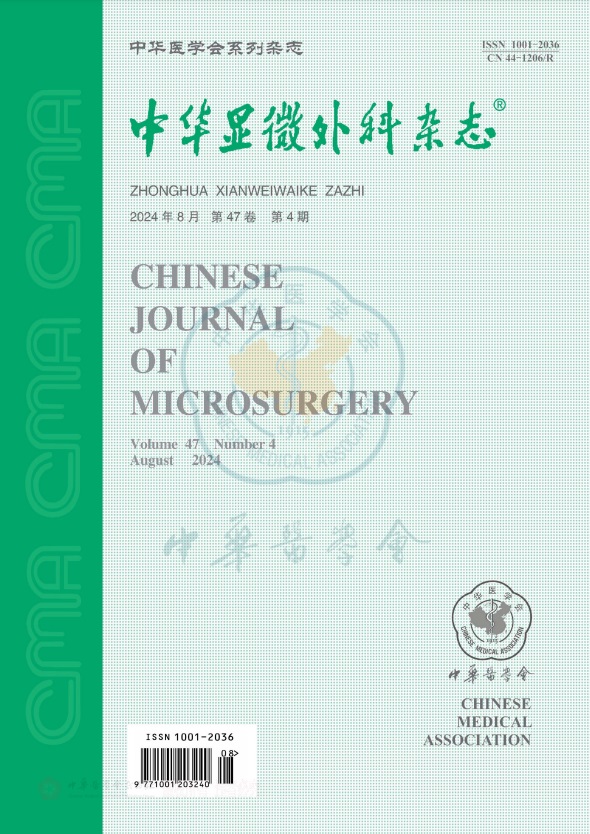Ten years retrospective study of using primary microsurgery technology to treat patients with severe lower extremities injury
引用次数: 0
Abstract
Objective To clarify the role of microsurgery in limb salvage procedure and its efficiency in longterm functional results through a retrospective review of patients who sustained severe injury of lower extremities and had been treated Shanghai 6th people's hospital, in recent 10 years. Methods Patients who sustained severe injury of lower extremities and treated with microsurgical techniques in January, 2006 to January, 2016 were studied. Patients' general information, classification of open fracture, and MESS were noted. The enrolled patients were divided into two groups(group A: primary microsurgical reconstruction; group B: non-microsurgical reconstruction) according to whether primary microsurgical reconstruction was performed or not. Each group were also further divided into subgroup according to preoperative MESS(MESS<7 and MESS≥7). The reconstruction methods, hospitalization days, operation times, postoperative complications, as well as the SIP were then recorded for each groups. The differences of these data among each groups were analyzed and compared. Results The main objection was patient with Gustilo grade III open fracture, totally 548 patients were admitted, with 312 males and 236 females. The main age was 35.6 years old. The main etiology was road traffic accident (79.7%). There were 211 patients (38.5%) in group A, and 337 patients (61.5%) in group B. In group A, there were 37 patients in subgroup one (MESS<7), and 174 patients in subgroup two(MESS ≥7). The rate of delayed amputation was 2.8%, while the complication rate was 11.8%. In group B, there were 181 patients in subgroup one(MESS<7), and 156 patients in subgroup two (MESS≥7). The rate of delayed amputation was 4.0%, while the complication rate was 13.3%. In long-term survey, the average VAS score of group B was higher than that of group A, but no significant difference was noted. The average VAS scores in 2 year postoperatively in the subgroups (MESS≥7) were higher than those in the other subgroups(MESS<7). The results of SIP scores were similar with VAS scores in two groups. Conclusion The techniques of microsurgery has been promoting the successful rates and outcomes for limb salvage procedure over the recent decades. Meanwhile, the current evaluating system for severe limb injury needs to be updated to meet the demands of ever-developing limb salvage techniques. Key words: Severe lower limb injury; Limb salvage; MESS; Microsurgical technique应用初级显微外科技术治疗重度下肢损伤的十年回顾性研究
目的通过对上海市第六人民医院近10年收治的下肢严重损伤患者的回顾性分析,阐明显微外科在保肢手术中的作用及其对远期功能结果的影响。方法对2006年1月至2016年1月接受显微外科技术治疗的严重下肢损伤患者进行研究。记录患者的一般信息、开放性骨折的分类和MESS。根据是否进行初级显微外科重建,将入组患者分为两组(A组:初级显微外科再造;B组:非显微外科再造)。各组还根据术前MESS进一步分为亚组(MESS<7和MESS≥7)。然后记录各组的重建方法、住院天数、手术次数、术后并发症以及SIP。分析并比较各组间这些数据的差异。结果主要反对GustiloⅢ级开放性骨折患者,共548例,其中男性312例,女性236例。主要年龄35.6岁。主要病因为道路交通事故(79.7%),A组211例(38.5%),B组337例(61.5%)。A组第一亚组37例(MESS<7),第二亚组174例(MESS≥7)。延迟截肢的发生率为2.8%,并发症发生率为11.8%。B组第一亚组181例(MESS<7),第二亚组156例(MESS≥7)。延迟截肢的发生率为4.0%,并发症发生率为13.3%。在长期调查中,B组的平均VAS评分高于A组,但无显著差异。术后2年各亚组的平均VAS评分(MESS≥7)均高于其他亚组(MESS<7)。两组的SIP评分结果与VAS评分结果相似。结论近几十年来,显微外科技术一直在提高保肢手术的成功率和效果。同时,目前严重肢体损伤的评估系统需要更新,以满足不断发展的肢体抢救技术的要求。关键词:严重下肢损伤;肢体抢救;混乱;显微外科技术
本文章由计算机程序翻译,如有差异,请以英文原文为准。
求助全文
约1分钟内获得全文
求助全文
来源期刊
CiteScore
0.50
自引率
0.00%
发文量
6448
期刊介绍:
Chinese Journal of Microsurgery was established in 1978, the predecessor of which is Microsurgery. Chinese Journal of Microsurgery is now indexed by WPRIM, CNKI, Wanfang Data, CSCD, etc. The impact factor of the journal is 1.731 in 2017, ranking the third among all journal of comprehensive surgery.
The journal covers clinical and basic studies in field of microsurgery. Articles with clinical interest and implications will be given preference.

 求助内容:
求助内容: 应助结果提醒方式:
应助结果提醒方式:


